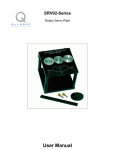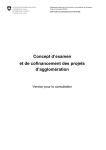Download Operating Instructions Linear Controller 4-Quadrant for - Q-TECH
Transcript
Linear Controller 4-Quadrant for DC-Micromotors Operating Instructions Series LC 3002 Operating Instructions c om w. fau w w l h er. b a Miniature Drive Systems Micro Drives DC-Micromotors Precision Gearheads Servo Components Drive Electronics Surf to the following Internet address and you will find the latest edition of the instruction manual on-line: www.minimotor.ch/uk/pr/ For direct Download: http://www.minimotor.ch/minicatalog/pdf/DriveCircuits/Manuals/IM_e_LC_3002.pdf Linear Controller Series LC 3002 Index 1. Description 2. Technical specifications 3. Dimensions and weight Page 1 1 1 4. Connector / Pin location 2 5. Wiring diagram for Motor-Tacho Feedback control (Speed control) 6. Wiring diagram for IR Compensation (Speed control) 3 3 7. Wiring diagram for Voltage drive (Voltage control) 8. Wiring diagram for Current control (Torque control) 4 4 9. 10. 11. 12. Enable input Current limiter Excess temperature protection Fault output 13. DIP Switch settings for various operating modes 14. On-board trimmers and LEDs 5 5 5 5 6 6 15. 16. 17. 18. 19. 20. RPM setting I-max setting I-dyn setting XP setting IR setting Offset setting 7 7 7 7 7 7 21. 22. 23. 24. Checklist Checklist Checklist Checklist 8 8 8 8 for Motor-Tacho Feedback control (Speed control) for IR Compensation (Speed control) for Voltage drive (Voltage control) for Current control (Torque control) 25. Trimmer settings 26. Connection example for Motor-Tacho Feedback control (Speed control), 24 V DC supply 9 9 27. Connection example for Motor-Tacho Feedback control (Speed control), 22 V AC supply 28. Connection example for IR Compensation (Speed control) 10 10 29. Connection example for Voltage drive (Voltage cotrol) 30. Connection example for Current control (Torque control) 11 11 31. Trouble shooting 12 CAUTION: Use the Servo Amplifier only in accordance with the set-up checklists on page 8. Linear Controller Series LC 3002 1. Description The linear 4-quadrant Servo Amplifier LC 3002 is designed for use with highly dynamic brush commutated DC-Micromotors which feature ironless rotors (System Faulhaber®). The linear design assures that no electromagnetic radiation is generated and eliminates the need for motor inductors. The Servo Amplifier LC 3002 can be used in a variety of configurations such as: • Motor-Tacho Feedback control (Speed control) • IR Compensation control (Speed control) • Voltage drive (Voltage control) • Current control (Torque control) The Servo Amplifier can be used either with DC or AC supply voltage. 2. Technical specifications Minimum Typical 1) Maximum Unit 40 2) W – 20 Power supply voltage: – DC supply – AC supply 12 10 – – 32 22 V DC V AC Motor supply voltage – – 26 V DC Output current max. – 2 – A Tachogenerator voltage – – 50 V Reference voltage – ±3 3) – V Command voltage – ±10 – V External command voltage I-dyn – 0–10 – V Nominal power 24 V DC – 20 mA max. Fault output (open collector) Temperature range: –operation –storage 0 –20 – – +70 4) +80 ˚C ˚C 1) 2) 3) 4) Maximum power which can be dissipated by the Servo Amplifier With additional heat sink Supply voltage for externally set potentiometer Derating at higher temperature to be taken in consideration 3. Dimensions and weight Size (Euro format) 100 x 160 mm Width 6 TE (30,48 mm) Weight 300 g 1 Specifications subject to change without notice Linear Controller Series LC 3002 4. Connector / Pin location The Servo Amplifier LC 3002 is supplied standard with a 15-pin connector type DIN 41612. 4 Power supply voltage AC/DC + 6 Power supply voltage AC/DC – 8 GND 10 Motor supply voltage + 12 Motor supply voltage – 14 Reference voltage output – 16 Reference voltage output + 18 Speed or torque command + 20 Speed or torque command – 22 Current limiter Idyn + 24 Current limiter Idyn – 26 Tachometer + 28 Tachometer – 30 Enable input 32 Fault output Type H15 6 10 14 18 22 26 30 Z d 4 8 12 16 20 24 28 32 2 Specifications subject to change without notice Linear Controller Series LC 3002 5. Wiring diagram for Motor-Tacho feedback control (Speed control) The actual motor speed is sensed with the tachogenerator. The reference command signal is given either with an external voltage of ±10 V or through a potentiometer directly connected to the amplifier. The total resistance of this potentiometer should be between 10 kΩ and 47 kΩ. Power supply voltage Motor DC-Motor Speed command potentiometer 4 AC (DC+) 6 AC (DC –) 8 GND 10 12 Motor + Motor – 14 Vref – 16 Vref + 18 ext. voltage 20 22 I-dyn limiter 24 Tacho 26 Tacho 28 Enable input 30 Fault output 32 Command I-dyn Tacho DC DC – + + – + – Enable Fault output 6. Wiring Diagram for IR Compensation (Speed control) The actual motor speed is determined by the motor voltage and motor current. The speed reference command is connected either through an external ±10 V or through a potentiometer directly connected to the amplifier. The total resistance of this potentiometer should be between 10 kΩ and 47 KΩ. Power supply voltage Motor DC-Motor Speed command potentiometer 4 AC (DC+) 6 AC (DC–) 8 GND 10 12 Motor + Motor – 14 Vref – 16 Vref + 18 ext. voltage Command 20 22 I-dyn limiter 24 26 28 Enable input 30 Fault output 32 3 I-dyn Tacho DC DC – + + – + – Enable Fault output Specifications subject to change without notice Linear Controller Series LC 3002 7. Wiring diagram for Voltage drive (Voltage control) Setting of a constant motor voltage (the motor speed is about proportional to the voltage). The reference command value is determined by an external voltage of ± 10 V. Power supply voltage Motor DC-Motor 4 AC (DC+) 6 AC (DC–) 8 GND 10 12 Motor + Motor – 14 Vref – 16 Vref + Voltage command Ext. voltage 18 I-dyn Limiter 22 Command 20 I-dyn 24 26 Tacho 28 Enable input Fault output 30 Enable 32 Fault output DC DC – + + – + – 8. Wiring diagram for Current control (Torque control) The actual torque is measured with the motor current. The reference command value is determined by an external voltage of ± 10 V or through a potentiometer directly connected to the amplifier. The total resistance of this potentiometer should be between 10 K - 47 K Ohms. Power supply voltage Motor DC-Motor Torque command potentiometer 4 AC (DC+) 6 AC (DC–) 8 GND 10 12 Motor + Motor – 14 Vref – 16 Vref + 18 Command 20 Ext. voltage I-dyn Limiter 22 24 26 I-dyn Tacho 28 Enable input Fault output 4 DC DC – + + – + – 30 Enable 32 Fault output Specifications subject to change without notice Linear Controller Series LC 3002 9. Enable input The Servo Amplifier LC 3002 is enabled when pins 8 and 30 are connected. Opening this connection disables the power stage. This input must be connected via a potentialfree contact (e.g.: relay contact). 10. Current limiter I-dyn I-max I-motor The maximum continuous current is set with the dynamic current limiter (I-dyn). This current can be exceeded for a short time up to the set value I-max (typical 2 A). In the event of short circuit (i.e., current greater than 3,5 A) the amplifier is immediately disabled. ∆t = depending on the charge process of an integrator. ∆t 11. Excess temperature protection The system automatically shuts off if the heat sink temperature exceeds 80˚C, preventing damage of the power bridge. 12. Fault output The Servo Amplifier LC 3002 uses an open collector output on pin 32 (Figure The fault output is activated in the following situations: ➊ ). • Activated dynamic current limiter • Motor in short circuit • Excess temperature on heat sink At the Fault Output either an LED (Figure ➋) or a relay (Figure ➌) can be connected. – + AC (DC+) 4 AC (DC+) 6 max. 24 V DC 8 Rv 32 + – External supply voltage Fault output 10 m A 32 GND 8 20 m A Figure ➊ Figure 5 32 ➋ 8 Figure ➌ Specifications subject to change without notice Linear Controller Series LC 3002 13. DIP Switch settings for various operating modes Operating mode / DIP Switches 1 2 3 4 Motor-Tacho regulation (Speed control) on A IR regulation (Speed control) on A Voltage drive regulation (Voltage control) on Current control regulation (Torque control) on 5 on 6 7 8 on on on 9 0 B on on B on on B A B A. DIP Switch 4 This switch should be off if the command signal comes from a potentiometer connected to the V-ref terminals. This switch should be on if an external voltage is used. B. DIP Switch 0 This switch should be on when the dynamic current limit I-dyn is set using the on-board trimmer. This switch should be off if the dynamic current limit I-dyn is externally set. 14. On-board trimmers and LEDs The on-board trimmers have a twenty (20) turn range. Before operating the amplifier the trimmers have to be set according to the following table. Position Function RPM CCW Min. speed Speed selection IR CCW Min. stiffness IR compensation Max. continuous current Continuous current I-dyn Offset XP I-max CW Middle CCW CW LED1 Zero output balance Min. stiffness Amplification control Max. intermittent current Short duration current Power Power supply indicator Green > I-max On if I-max is exceeded Red LED3 > T-max On if excess temperature Red ▼ ▼ ▼ ▼ ▲ ▼ ▼ red Note: In different operating modes not all trimmers will be used. Unused trimmers should be set to the positions given in the table. red green RPM IR I-dyn Offset XP I-max Power I-max T-max LED2 ⊗ ⊗ ⊗ 6 Specifications subject to change without notice Linear Controller Series LC 3002 15. RPM setting Scope: The desired max. motor speed is set with the RPM trimmer. Action: Input a reference command voltage or set a value via external potentiometer according to the desired max. speed. Turn the RPM trimmer CW until the motor reaches a speed corresponding to the max. set value. 16. I-max setting Scope: The desired max. peak current is set with the I-max trimmer. Action: Use a digital amp. meter connected in series with motor. Stall the motor. Turn the I-max trimmer CCW until the max. permissible current is reached. Note: Make this adjustment as fast as possible, since the dynamic current limiter will be activated after a short period of time. 17. I-dyn setting Scope: The dynamic current limitation is set with the I-dyn trimmer. Action: Use a digital amp. meter connected in series with motor. Stall the motor. Turn the I-dyn trimmer CCW until the max. permissible continuous current is reached. 18. XP setting Scope: The amplifier’s gain and therefore also its operating stability (stiffness) is set with the XP trimmer. Action: Run the motor at a low speed by input of a corresponding set value. Turn the XP trimmer CW until the motor starts vibrating (swinging), then turn the trimmer one full turn CCW. 19. IR setting Scope: The amplifier’s gain and therefore also its operating stability (stiffness) is set with the IR trimmer. Action: Run the motor at a low speed by input of a corresponding set value. Turn the IR trimmer CW until the motor starts vibrating (swinging), then turn the trimmer one full turn CCW. 20. Offset setting Scope: Zero speed or motor standstill between rotation directions is set with the offset trimmer. Action: Input 0 (zero) set value. Turn the offset trimmer CW or CCW until the motor shaft does not turn. 7 Specifications subject to change without notice Linear Controller Series LC 3002 21. Checklist for Motor-Tacho Feedback control (Speed control) Action References – Connect the LC 3002 5 Wiring diagram Motor-Tacho Feedback control – Preset potentiometer 14 On-board trimmers and LEDs – Set operation mode, apply power 13 DIP Switch settings for various operating modes – Set RPM 15 RPM setting – Set I-max 16 I-max setting – Set I-dyn 17 I-dyn setting – Set XP 18 XP setting – Set offset 20 Offset setting B (on) Trimmer I-dyn B (off) ext. I-dyn A B 1 2 3 4 5 6 7 8 9 0 on ↔ A (off) Poti over V-ref A (on) ext. set value off Switch settings 22. Checklist for IR Compensation (Speed control) Action References – Connect the LC 3002 6 Wiring diagram IR Compensation – Preset potentiometer 14 On-board trimmers and LEDs – Set operation mode, apply power 13 DIP Switch settings for various operating modes – Set RPM 15 RPM setting – Set I-max 16 I-max setting – Set I-dyn 17 I-dyn setting – Set IR 19 I x R setting – Set offset 20 Offset setting B (on) Trimmer I-dyn B (off) ext. I-dyn A B 1 2 3 4 5 6 7 8 9 0 ↔ on A (off) Poti over V-ref A (on) ext. set value off Switch settings 23. Checklist for Voltage drive (Voltage control) Action References – Connect the LC 3002 7 Wiring diagram for Voltage drive – Preset potentiometer 14 On-board trimmers and LEDs – Set operation mode, apply power 13 DIP Switch settings for various operating modes – Set RPM 15 RPM setting – Set I-max 16 I-max setting – Set I-dyn 17 I-dyn setting – Set offset 20 Offset setting 1 2 3 4 5 6 7 8 9 0 ↔ on B B (on) Trimmer I-dyn B (off) ext. I-dyn off Switch settings 24. Checklist for Current control (Torque control) Action References – Connect the LC 3002 8 Wiring diagram for Current control – Preset potentiometer 14 On-board trimmers and LEDs – Set operation mode, apply power 13 DIP Switch settings for various operating modes B (on) Trimmer I-dyn B (off) ext. I-dyn A B 1 2 3 4 5 6 7 8 9 0 8 on ↔ A (off) Poti over V-ref A (on) ext. set value off Switch settings Specifications subject to change without notice Linear Controller Series LC 3002 ▼ ▼ ▼ ▼ ▲ ▼ ▼ red red green RPM IR I-dyn Offset XP I-max Power I-max T-max 25. Trimmer settings RPM CCW Min. Speed IR CCW Min. Stiffness I-dyn CW Max. Continuous current Offset Center XP CCW Min. Stiffness I-max CW Max. Current ⊗ ⊗ ⊗ Note: Motor supply voltage selection The voltage loss in the Servo Amplifier is 6 Volts. Therefore, the maximum possible motor supply voltage is always 6 Volts less the power supply voltage of the amplifier. 26. Connection example for Motor-Tacho Feedback control (Speed control), 24 V DC supply Common supply. Set value and I-dyn via PLC, PC, etc., without enable control and failure scan. Power supply 24 V DC LC 3002A 0-18V M PLC, PC… D A D ±10V A 0-10V A GND Digital Out Digital In + T AC (DC+) 6 AC (DC –) 8 GND 10 Motor + 12 Motor – 14 Vref – 16 Vref + 18 28 – Command + + I-dyn – + Tacho – 30 Enable 32 Fault output 20 22 24 26 DC DC on 1 2 3 4 5 6 7 8 9 0 ↔ Power supply 4 off Switch settings 9 Specifications subject to change without notice Linear Controller Series LC 3002 27. Connection example for Motor-Tacho Feedback control (Speed control), 22 V AC supply Separate AC supply for the LC 3002. Set value and I-dyn via PLC, PC, etc., with enable control and failure scan. Power supply 220 V AC LC 3002A 22 V AC Power supply 0-24V M PLC, PC… D A D ±10V A 0-10V A GND Digital Out + Digital In T 4 AC (DC+) 6 AC (DC –) 8 GND 10 Motor + 12 Motor – 14 Vref – 16 Vref + 18 28 – Command + + I-dyn – + Tacho – 30 Enable 32 Fault output 20 22 24 26 DC DC on 1 2 3 4 5 6 7 8 9 0 ↔ 24 V DC off Switch settings 28. Connection example for IR Compensation (Speed control) Common supply. Set values RPM and I-dyn via PLC, PC, etc., without enable control and failure scan. Power supply 24 V DC LC 3002A 0-18V M PLC, PC… D A D ±10V A 0-10V A GND Digital Out 4 AC (DC+) 6 AC (DC –) 8 GND 10 Motor + 12 Motor – 14 Vref – 16 Vref + 18 28 – Command + + I-dyn – + Tacho – 30 Enable 32 Fault output 20 22 24 26 Digital In + DC DC on 1 2 3 4 5 6 7 8 9 0 ↔ Power supply off Switch settings 10 Specifications subject to change without notice Linear Controller Series LC 3002 29. Connection example for Voltage amplifier (Power amplifier) Common supply. Set value and I-dyn setting via PLC, PC, etc. Enable control via PLC, without failure scan. Power supply 24 V DC Power supply 0-18V D M A D ±10V A 0-10V A GND Digital Out AC (DC+) 6 AC (DC –) 8 GND 10 Motor + 12 Motor – 14 Vref – 16 Vref + 18 28 – Command + + I-dyn – + Tacho – 30 Enable 32 Fault output 20 22 24 26 + Digital In DC DC on 1 2 3 4 5 6 7 8 9 0 ↔ PLC, PC… LC 3002A 4 off Switch settings 30. Connection example for Current control (Torque control) Common supply. Set value for torque and I-dyn via PLC, PC, etc., without enable control and failure scan. Power supply 24 V DC LC 3002A 0-18V M PLC, PC… D A D ±10V A 0-10V A GND Digital Out 4 AC (DC+) 6 AC (DC –) 8 GND 10 Motor + 12 Motor – 14 Vref – 16 Vref + 18 28 – Command + + I-dyn – + Tacho – 30 Enable 32 Fault output 20 22 24 26 Digital In + DC DC on 1 2 3 4 5 6 7 8 9 0 ↔ Power supply off Switch settings 11 Specifications subject to change without notice Linear Controller Series LC 3002 31. Trouble shooting If difficulties are experienced, please check the following points: ● Check connections: Are motor leads reversed? Are tacho leads reversed? Is Enable (pin 30) connected to GND (pin 8)? ● Check DIP switch settings. ● Follow the checklists, in proper order (page 8). ● Always be sure that the potentiometers are in their starting positions. 12 Specifications subject to change without notice The FAULHABER Group: DR. FRITZ FAULHABER GMBH & CO. KG Daimlerstraße 23 71101 Schönaich · Germany Tel.: +49 (0)7031/638-0 Fax: +49 (0)7031/638-100 Email: [email protected] www.faulhaber.de MINIMOTOR SA 6980 Croglio · Switzerland Tel.: +41 (0)91 611 31 00 Fax: +41 (0)91 611 31 10 Email: [email protected] www.minimotor.ch MicroMo Electronics, Inc. 14881 Evergreen Avenue Clearwater · FL 33762-3008 · USA Phone: +1 (727) 572-0131 Fax: +1 (727) 573-5918 Toll-Free: (800) 807-9166 Email: [email protected] www.micromo.com ©MINIMOTOR SA Edition 15.09.2000
















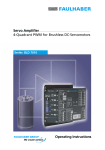
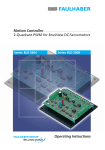
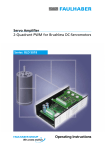
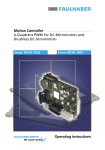
![Final Report - [Almost] Daily Photos](http://vs1.manualzilla.com/store/data/005658230_1-ad9be13b69bd4f2e15f58148160b0f22-150x150.png)
